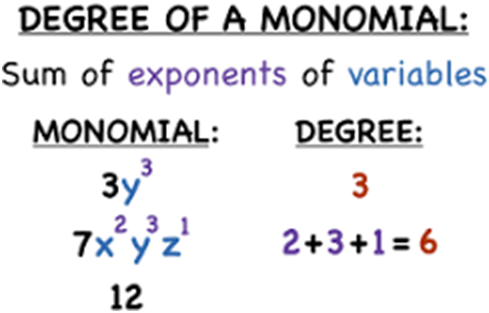LEARN MATH STEP BY STEP THROUGH VERY EASY PROCESS
CLASS-6
DEGREE OF MONOMIAL
DEGREE OF MONOMIAL -
The degree of a monomial is determined by the sum of the exponents of its variables. In other words, it is the highest power to which any variable within the monomial is raised. Here are some key points about the degree of a monomial:
- Degree Definition:- The degree of a monomial is the sum of the exponents of its variables.
- Variables with Exponents:- A monomial may contain one or more variables, each raised to a non-negative integer exponent.
- Constant Term:- If a monomial does not contain any variables (i.e., all exponents are zero), its degree is considered to be 0.
- Degree Notation:- The degree of a monomial is often denoted as "n."

Here are some examples to illustrate the concept of the degree of a monomial:-
- Constant Monomial:- "5" is a constant monomial, and its degree is 0 because it does not contain any variables (i.e., no variables are raised to non-zero exponents).
- Linear Monomial:- "3x" is a linear monomial, and its degree is 1 because the variable "x" is raised to the first power.
- Quadratic Monomial:- "2y²" is a quadratic monomial, and its degree is 2 because the variable "y" is raised to the second power.
- Mixed Monomial:- "4x²y" is a mixed monomial with multiple variables. To find its degree, add the exponents: 2 (from "x²") + 1 (from "y") = 3. So, the degree of "4x²y" is 3.
- Variable Raised to Zero:- "1" is a monomial that may appear to have no variables, but it can also be considered a variable (any variable raised to 0 is equal to 1). Therefore, its degree is 0.
Understanding the degree of a monomial is important in algebra, especially when simplifying expressions, finding solutions to equations, and classifying polynomial expressions based on their degree. It provides information about the highest power of the variables within the monomial.